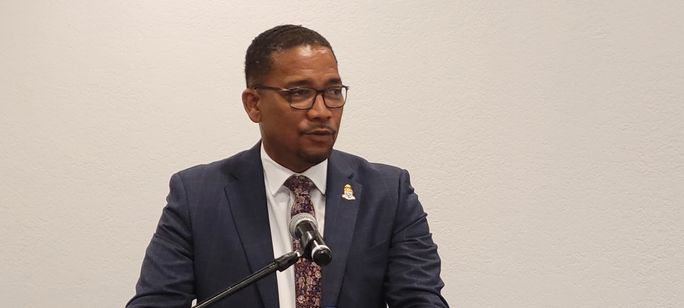by Brian Major
Last updated: 1:45 PM ET, Wed September 18, 2024
The Cayman Islands government this week advanced a motion for
a public referendum to determine if the Caribbean nation will establish a cruise
berthing facility.
The success or failure of the referendum could determine Caribbean
cruising’s development in the coming years.
Supported by Kenneth Bryan, the Cayman Islands tourism minister,
the referendum would ask Cayman citizens a sole question: “Should the Cayman
Islands develop cruise berthing infrastructure?”
The motion is expected to be debated when parliament meets in
October. A date for the proposed referendum has not been announced, but Bryan
previously said a referendum could happen by late October or mid-November,
according to a Cayman News Service report.
The motion is expected to pass through parliament as both
the government and opposition legislators support it, the report says. Should
that occur, the government will next publish a referendum act, followed by a
28-day public consultation process.
The consultation period could be waived if Juliana O’Connor-Connolly,
the Cayman Islands’ premier, determines the matter to be urgent. The legislation
would then go to the Cayman parliament for debate and vote.
The most recent initiative follows the collapse of a $250
million port project proposed by the government, in partnership with several
cruise lines, in 2019.
The government later abandoned the project after citizens who
opposed it, citing environmental and other concerns, formed the Cruise Port
Referendum Cayman (CRP Cayman) group, which gathered enough signatures on a
petition to force a referendum.
The present-day referendum seeks a “directive” from Cayman
citizens, said Bryan. Unlike prior to the previous referendum, there is presently
no proposed plan to build a cruise pier.
Speaking at the Caribbean Tourism Organization (CTO)’s State
of the Industry (SOTIC) conference in Grand Cayman earlier this month, Rick Sasso, chairman
of MSC Cruises North America, said a fixed pier would ensure the country’s future as a Caribbean cruise
destination as ship scale increases.
“There needs to be an easy way for guests to disembark from
these huge ships and to do it cleanly, safely and quickly,” Sasso said, “so
they spend more time ashore and not going back to some queue at three o’clock
in the afternoon to get back on the ship, which has to leave an hour earlier
because of that.”
A fixed pier would add more time to guests’ experience in
the destination, Sasso said. “Lengthening the guest experience is a must and
that’s what we’ll have with a new cruise pier,” he said.
“You can almost add two or three hours of shore experience
and give people multiple chances to see everything in the Cayman Islands by
having a pier for two ships or three or four,” said Sasso.

“We’re just over 30 percent [down] while all of the other Caribbean islands have above pre-covid [cruise arrival] numbers.” – Kenneth Bryan, Cayman Islands tourism minister. (Photo by Brian Major)
At one point during a SOTIC cruise panel discussion, Bryan
asked both Candib to “describe the picture with no pier. What will happen to
the numbers?”
Said Bryan, “My projections are that the numbers will continue
to decline. Right now, we’re just over 30 percent [down] while all of the other
Caribbean islands have above pre-covid [cruise arrival] numbers.”
David Candib, vice president of port operations for
Carnival Cruise Line, confirmed that the newest generation of cruise ships is
unlikely to visit the Cayman Islands.
“I was heavily involved in the prior process as part of the
preferred bidders,” Candib said. “At that point in time we shared that Carnival
Cruise Line [is] looking to build larger ships. We made an operational decision
that those ships won’t call on ports that are tender ports.”
He continued, “Relative to the amount of guests, the
experience [and] the challenges to tender guests and crew in and out, it’s not
the experience we want to offer. With 6,500 to 8,000 guests and another 1,500
to 2,000 crew, it’s just something as a company and an industry we are not
doing with those ships.”
Candib said the Cayman Islands’ lack of a fixed pier has
influenced Carnival’s future deployment away from the western Caribbean. “We
have three mega-ships in operation today, one from Galveston, and two in
Florida,” he said, “and they’re not calling on any destinations that require
tendering.”
Carnival has ordered five new ships, all equal to or bigger
than its largest present-day vessels, Canidib said. “Those ships will replace
ships that would have called at Grand Cayman and the western Caribbean,” he said.
“Since the introduction of the larger ships into the fleet, we have seen a reduction
in calls to Grand Cayman.”
A “domino effect” could hasten the decline in cruise calls
at the Cayman Islands, added Candib. The larger ships “may go on itineraries
that replace ships calling on destinations today that require tendering,” he
noted.
Sasso said that the Cayman Islands’ location makes it a key
port of call on Western Caribbean itineraries, which could wither without a stop
in Grand Cayman available.
“Geographically, you’re in an incredible place,” he said. “When
you think about your [close proximity] to Mexico and Jamaica, it’s almost like
a no-brainer that ships should pass by here and stop and not keep going like
some of the bigger ships are because of the tender situation.”
Cayman Islands citizens must not only face the question of
attracting cruise ships in the future, but also the nature of tourism to the
destination, as additional guests from larger vessels will impact the country and
place new demands on land-based resources.
The destination must also contend with cruise lines that
are, in Candib’s words, “doing port developments on our own” in partnership with
countries including the Bahamas, Mexico, the Dominican Republic and Honduras.
“We’re doing that because we need the service,” he said. “These
ships are on order and we know they’re coming. It takes time to work through
all of the environmental impacts elements to make sure mitigate them and [create]
a sustainable facility.”
Meanwhile, pro-cruise interests in the Cayman territory have
formed the Association for the Advancement of Cruise Tourism in the Cayman
Islands (ACT) as a local lobbying group, while CPR Cayman has resurfaced to encourage a “no” vote.
For the latest travel news, updates and deals, subscribe to the daily TravelPulse newsletter.
Topics From This Article to Explore
Source link : http://www.bing.com/news/apiclick.aspx?ref=FexRss&aid=&tid=66eb1a02aeab4fbf882d3cc5088b2108&url=https%3A%2F%2Fwww.travelpulse.com%2Fnews%2Fdestinations%2Fcayman-referendum-could-determine-caribbean-cruising-s-future&c=5102280355400282788&mkt=en-us
Author :
Publish date : 2024-09-18 07:17:00
Copyright for syndicated content belongs to the linked Source.




